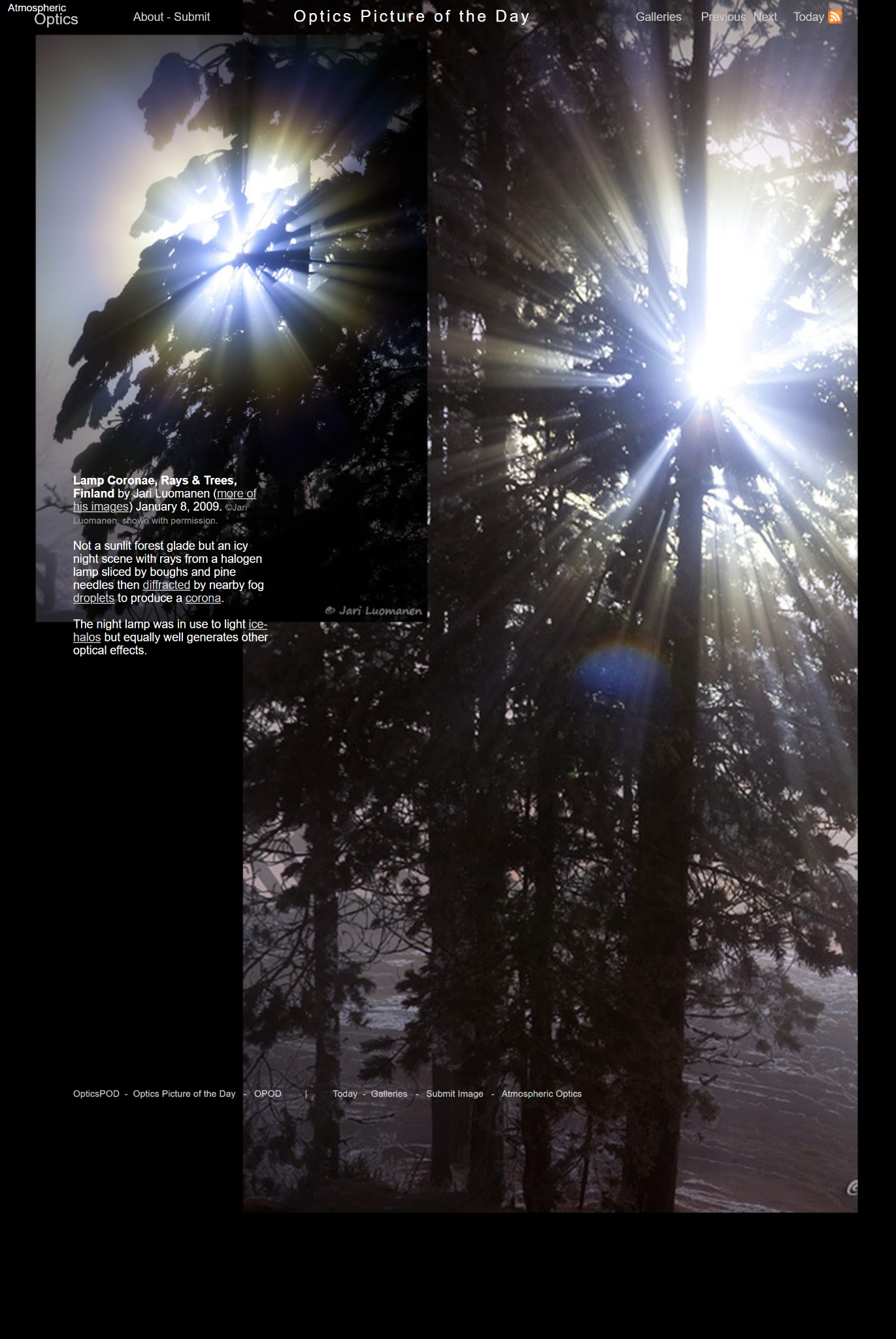Lamp Coronae, Rays & Trees
Lamp Coronae, Rays & Trees: A Closer Look at Atmospheric Optics
Atmospheric optics is a fascinating field that explores the various optical phenomena that occur in the Earth's atmosphere. One such phenomenon is the formation of lamp coronae, rays, and their interaction with trees. These mesmerizing displays can be observed in diverse settings, ranging from sunlit forests to icy night scenes illuminated by artificial lamps. In this article, we will delve deeper into the intricate details of lamp coronae, rays, and their interaction with trees.
The Creation of Lamp Coronae
Lamp coronae are optical phenomena that occur when light passes through tiny water droplets or ice crystals suspended in the air. When a beam of light from a lamp encounters these particles, it gets diffracted and scattered, resulting in the formation of a corona. This corona appears as a series of colored rings or halos surrounding the light source.
The intricate patterns seen in lamp coronae are influenced by several factors, including the size and shape of the droplets or crystals, as well as the wavelength of light. The presence of fog or mist in the vicinity further enhances the formation of these captivating displays. It is worth noting that lamp coronae can also be observed around other light sources, not just the sun.
The Role of Trees in Lamp Coronae
Trees play an intriguing role in the formation of lamp coronae. When a beam of light from a lamp passes through the branches and foliage of trees, it becomes fragmented and sliced into multiple rays. These rays interact with the surrounding atmospheric particles, such as fog droplets or ice crystals, leading to diffraction and scattering effects that contribute to the creation of coronae.
The complex interplay between light, trees, and atmospheric particles results in mesmerizing visual displays. The intricate network of branches and leaves acts as a canvas upon which the rays and coronae are painted. Each tree becomes a unique contributor to the overall spectacle, adding its own distinctive pattern and arrangement of rays.
The Beauty of Lamp Rays
In addition to coronae, lamp rays are another captivating atmospheric optical phenomenon. These rays appear as beams of light radiating from the lamp source. When passing through the trees, the rays become fragmented and dispersed, creating an ethereal and enchanting effect.
The density and arrangement of branches and foliage influence the pattern and direction of the rays. As the light interacts with the intricate structure of the trees, it undergoes diffraction, scattering, and reflection, resulting in a mesmerizing interplay of light and shadows. The ever-changing movement of the branches and leaves adds a dynamic element to the scene, further enhancing the beauty of the lamp rays.
Other Optical Effects Generated by Lamps
While lamp coronae and rays are the most prominent optical effects generated by lamps, they are not the only ones. Artificial light sources can produce a wide range of atmospheric optical phenomena, each with its own unique characteristics. Some of these effects include:
- Glories: Circular rings of colored light that appear around the shadow of the observer when illuminated by a lamp.
- Brocken spectres: Giant shadows cast onto clouds or fog when a lamp shines from behind the observer.
- Light pillars: Vertical columns of light that extend above and below a lamp, caused by the reflection of light from ice crystals in the air.
- Halos: Circular or elliptical rings of light that surround the lamp, similar to coronae but with a larger radius.
These diverse optical effects add to the captivating nature of atmospheric optics, offering a multitude of visual spectacles for observers to enjoy and study.
The Magic of Atmospheric Optics
Atmospheric optics is a field that continues to fascinate scientists, photographers, and nature enthusiasts alike. The intricate interplay between light, atmospheric particles, and natural or artificial structures produces breathtaking displays that captivate the imagination.
Lamp coronae, rays, and their interaction with trees are just a glimpse into the vast realm of atmospheric optics. By understanding the underlying physics and observing these phenomena in different settings, we can gain a deeper appreciation for the beauty and complexity of our atmosphere.
So, the next time you find yourself in a sunlit forest glade or an icy night scene illuminated by a lamp, take a moment to marvel at the enchanting dance of light and nature unfolding before your eyes. The world of atmospheric optics awaits, ready to reveal its secrets and wonders.

Lamp Coronae, Rays & Trees, Finland by Jari Luomanen (more of his images) January 8, 2009. ©Jari Luomanen, shown with permission.
Not a sunlit forest glade but an icy night scene with rays from a halogen lamp sliced by boughs and pine needles then diffracted by nearby fog droplets to produce a corona.
The night lamp was in use to light ice-halos but equally well generates other optical effects.
Note: this article has been automatically converted from the old site and may not appear as intended. You can find the original article here.
Reference Atmospheric Optics
If you use any of the definitions, information, or data presented on Atmospheric Optics, please copy the link or reference below to properly credit us as the reference source. Thank you!
-
<a href="https://atoptics.co.uk/blog/lamp-coronae-rays-trees/">Lamp Coronae, Rays & Trees</a>
-
"Lamp Coronae, Rays & Trees". Atmospheric Optics. Accessed on April 25, 2024. https://atoptics.co.uk/blog/lamp-coronae-rays-trees/.
-
"Lamp Coronae, Rays & Trees". Atmospheric Optics, https://atoptics.co.uk/blog/lamp-coronae-rays-trees/. Accessed 25 April, 2024
-
Lamp Coronae, Rays & Trees. Atmospheric Optics. Retrieved from https://atoptics.co.uk/blog/lamp-coronae-rays-trees/.